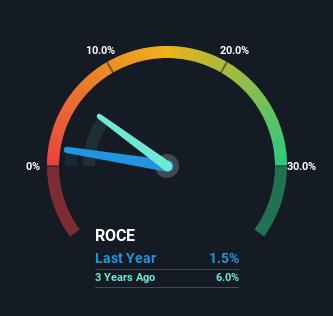- Singapore
- /
- Consumer Services
- /
- SGX:RQ1
Overseas Education's (SGX:RQ1) Returns On Capital Not Reflecting Well On The Business
To avoid investing in a business that's in decline, there's a few financial metrics that can provide early indications of aging. Typically, we'll see the trend of both return on capital employed (ROCE) declining and this usually coincides with a decreasing amount of capital employed. Ultimately this means that the company is earning less per dollar invested and on top of that, it's shrinking its base of capital employed. So after glancing at the trends within Overseas Education (SGX:RQ1), we weren't too hopeful.
Understanding Return On Capital Employed (ROCE)
If you haven't worked with ROCE before, it measures the 'return' (pre-tax profit) a company generates from capital employed in its business. To calculate this metric for Overseas Education, this is the formula:
Return on Capital Employed = Earnings Before Interest and Tax (EBIT) ÷ (Total Assets - Current Liabilities)
0.015 = S$3.6m ÷ (S$262m - S$29m) (Based on the trailing twelve months to June 2022).
Therefore, Overseas Education has an ROCE of 1.5%. In absolute terms, that's a low return and it also under-performs the Consumer Services industry average of 8.2%.
Check out our latest analysis for Overseas Education

While the past is not representative of the future, it can be helpful to know how a company has performed historically, which is why we have this chart above. If you'd like to look at how Overseas Education has performed in the past in other metrics, you can view this free graph of past earnings, revenue and cash flow.
How Are Returns Trending?
In terms of Overseas Education's historical ROCE movements, the trend doesn't inspire confidence. About five years ago, returns on capital were 4.9%, however they're now substantially lower than that as we saw above. Meanwhile, capital employed in the business has stayed roughly the flat over the period. This combination can be indicative of a mature business that still has areas to deploy capital, but the returns received aren't as high due potentially to new competition or smaller margins. If these trends continue, we wouldn't expect Overseas Education to turn into a multi-bagger.
In Conclusion...
In summary, it's unfortunate that Overseas Education is generating lower returns from the same amount of capital. Despite the concerning underlying trends, the stock has actually gained 5.4% over the last five years, so it might be that the investors are expecting the trends to reverse. Either way, we aren't huge fans of the current trends and so with that we think you might find better investments elsewhere.
On a final note, we found 6 warning signs for Overseas Education (2 are concerning) you should be aware of.
For those who like to invest in solid companies, check out this free list of companies with solid balance sheets and high returns on equity.
New: AI Stock Screener & Alerts
Our new AI Stock Screener scans the market every day to uncover opportunities.
• Dividend Powerhouses (3%+ Yield)
• Undervalued Small Caps with Insider Buying
• High growth Tech and AI Companies
Or build your own from over 50 metrics.
Have feedback on this article? Concerned about the content? Get in touch with us directly. Alternatively, email editorial-team (at) simplywallst.com.
This article by Simply Wall St is general in nature. We provide commentary based on historical data and analyst forecasts only using an unbiased methodology and our articles are not intended to be financial advice. It does not constitute a recommendation to buy or sell any stock, and does not take account of your objectives, or your financial situation. We aim to bring you long-term focused analysis driven by fundamental data. Note that our analysis may not factor in the latest price-sensitive company announcements or qualitative material. Simply Wall St has no position in any stocks mentioned.
About SGX:RQ1
Overseas Education
An investment holding company, operates a foreign system school in Singapore.
Adequate balance sheet with slight risk.
Similar Companies
Market Insights
Community Narratives




